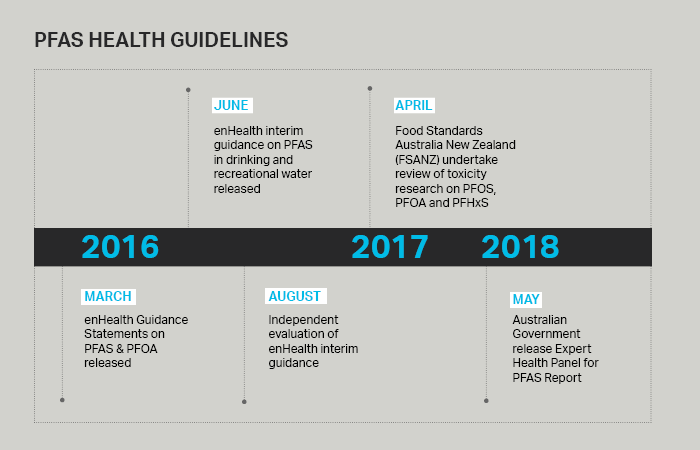PFAS health implications — What does the research tell us?
The Expert Health Panel for PFAS Report (the Panel), recently released by the Australian Government’s Department of Health, was the fifth report on the potential health effects of exposure to PFAS prepared by Australian health experts since 2016. The Panel concluded that there is limited or no evidence that human exposure to PFAS is linked with human disease, including overall cancer risk. However, the Panel also identified that there are gaps in our understanding of health effects of PFAS, and that their known ability to persist and accumulate in the body is a rationale for minimising exposure to these chemicals. This application of the precautionary principle represents a real challenge for risk communication in PFAS-contaminated areas, and makes a collaborative approach to planning and delivering human health risk assessments essential.
The Expert Health Panel for PFAS Report’s findings
An Expert Panel was setup in 2017 by the Australian Government to provide advice on the potential health impacts from exposure to PFAS and identify priority areas for further research. The Panel included representation from academics, medical specialists and environmental or public health experts. Some key findings of the Panel were:
- There is mostly limited or no evidence for any link with human disease, and no current evidence that supports a large impact on a person’s health as a result of high levels of PFAS exposure
- There is no current evidence that suggests an increase in overall cancer risk as a result of PFAS exposure
- Where studies have identified a link between exposure to PFAS and a health effect, it cannot be conclusively determined whether the exposure has caused the health effect or whether a third factor may have had an influence.
However, the Panel also concluded that:
- The current evidence is not sufficient to entirely rule out the potential for health effects
- Evidence of persistence and accumulation of these chemicals was sufficient to drive decisions regarding regulation or avoiding exposure, despite the low evidence for health effects.
These findings are consistent with the conclusions of the previous reports identified below:

Risk communication challenges
The Expert Health Panel report (and the reports that precede it) highlights a significant challenge that the available research into the potential health effects of PFAS presents for risk communication. While there are no confirmed health effects from PFAS, in some cases it is advised to minimise exposure and even avoid everyday practices such as drinking water from particular sources or eating home-grown food. Communicating this message is made even more difficult by the availability of information (and misinformation) via the internet; in particular, materials that have not been peer reviewed or are based on regulatory approaches different to those adopted in Australia.
In addition, there is a common misconception that screening values are thresholds above which a health effect will occur. In fact, screening values are intended to be used as thresholds at and below which no adverse health effect is considered likely to occur. The strong presence of the media and their potential influence on the broader public is also a challenge.
To ensure human health risk assessments for PFAS sites are delivered productively, the following points should be considered before commencing a PFAS assessment project:
- Ensure the risk communication approach is planned out with relevant parties and regularly review it at key milestones to learn from stakeholder interactions
- Generic assumptions should be avoided and site-specific information should be used wherever feasible (which will often mean collecting additional or different data)
- Avoid using overly technical jargon and use clear and concise language the stakeholders can relate to and easily understand
- There is a clear explanation of the “no adverse health effect” basis of Australian screening criteria that have been adopted as a precautionary measure to help minimise exposure, and that they are typically based on lifetime exposure (which means that occasional exceedances of these criteria are not likely to be of health concern)
- If the assessment identifies risk estimates exceeding the “acceptable” limits, this does not mean that health impacts will occur and it needs to be clearly explained that any subsequent recommendations to minimise exposure are based on the precautionary principle.
There is still further research and consideration required in relation to the health effects associated with PFAS exposure, as the evidence is not sufficient to entirely rule out the potential for health effects. A number of future research priorities have been suggested by the Panel, including consideration of health effects based on long-term studies to reduce the risk of bias and confounding; however, until then the advice is still focused on minimising exposure to these chemicals.
Author: Dr Michael Archer
